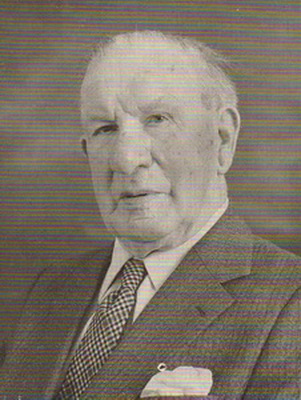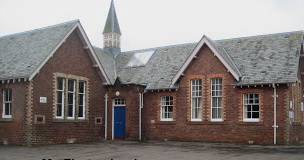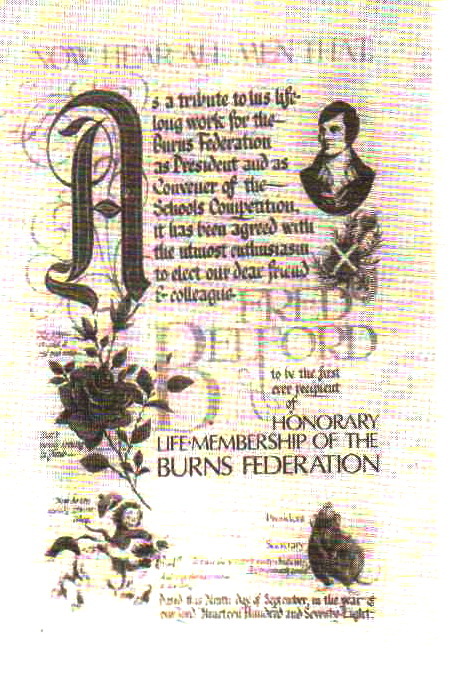Fred Belford was born in Gordon in 1886. It’s hard to imagine that anyone, in the long history of ‘Let it Blaw’, was more influential in Burnsian circles than Fred. Educated at George Heriot’s School and Edinburgh University, he pursued a career in education which saw him appointed Headmaster of Balerno School in 1923 …….
=============================================
” Fred “
Born 12th March 1886 in Gordon, Berwickshire
Died 24th February 1980 in Edinburgh, aged 93
–
The first and only Honorary Life Member of the Burns Federation
–
Honorary President of the Burns Federation
1960 – 1980
–
President of the Burns Federation
1959
–
Honorary Vice President of the Burns Federation
1955
—
Past President of the Scottish Burns Clubs Association
Past President of the Edinburgh District Burns Clubs Association
–
Vice-President
1926, 1927, 1928, 1929, 1930, 1931
Croupier
1926, 1928, 1929
—
Proposer of the Toast “Commercial Interests of the District” 1923
Proposer of the Toast “The Immortal Memory of Robert Burns” 1924, 1956, 1968
Proposer of the Toast “The Lasses” 1924
Proposer of the Toast “Other Poets” 1925
Reply to the Toast “Kindred Clubs” 1926, 1931
Proposer of the Toast “Kindred Clubs” 1927
Reply the Toast “Let it Blaw – The Balerno Burns Club” 1929
Served on the Club Committee
1923, 1924, 1925


- Balerno School
Although his stay in Balerno was a relatively short nine years, he made his mark in many aspects of village life, not least at ‘Let it Blaw’.
Fred fought in the 1914-18 war with the Royal Scots and, in 1917, was wounded at Ypres resulting in a lengthy stay in hospital. He possessed many artistic abilities and one of them was put to good use while lying in hospital by creating the most wonderful pictures not by painting, but by cutting up old postage stamps to create ‘works of art’. Another of his artistic abilities was tapestry work and some of his work was exhibited. Fred played golf, bowls and he did a bit of hill climbing. In later life he was also very proud to be a member of two Masonic Clubs of which Burns had been a member; Tarbolton St James No. 178 Masonic Lodge, and also the Canongate Kilwinning No.2 Lodge.
On arrival in Balerno, Fred met the Rev. David Stewart, Minister of Currie Parish of which, at that time, Balerno formed part. Fred’s introduction to Burns started when David, who was Chaplain of ‘Let it Blaw’, invited him to propose the ‘Immortal Memory’ at what Fred believed to be a church function. He declined the invitation due to his poor knowledge of the Bard but, typical of him, he didn’t want to let the Minister down and so Fred allowed himself to be talked into it. Fred went to the library and delved into a volume of Burns to see what he could find, and so began his first Immortal Memory with Fred starting the long climb to the very top of the Burns movement. To his horror he soon discovered that as opposed to the Church function he thought he was attending, he had to speak at the Ayrshire Association of Burns Clubs. This made Fred very nervous and, in case he made errors, he read every word of his Toast from notes. Whether he felt guilt, or just merely uncomfortable at presenting his oration in such a manner, from that day on Fred never used a note while giving an ‘Immortal Memory’ or when making a speech of any kind.
‘Let it Blaw’ records show that Fred’s first appearance at a Club event was the annual Supper held on 26th January 1923. He didn’t waste any time getting involved as he proposed the ‘Toast to Commercial Interests’ at the event, then also replied to the ‘Toast to New Members’; Fred Belford had arrived. He threw himself into Burns and ‘Let it Blaw’ and, two months later, presented a paper at the Club’s monthly meeting relating to Burns’ stay at Ellisland.
Fred became a keen, passionate and knowledgeable Burnsian. One year into his membership at the 1924 Supper, Fred proposed the ‘Toast Immortal Memory of Burns’ AND the ‘Toast to the Lasses’. He also played his part in the Songs and Recitations that year and found himself, shortly after, appointed to the Club Committee. In 1925, he proposed the ‘Toast to other Poets’. In 1926 he replied to the ‘Toast to Kindred Clubs’ and had been elevated to Vice President, a position he held for six years. There were other songs and recitations and, on two occasions, together with Thomas Horsburgh and John Fairbairn, he performed ‘Willie Brew’d a Peck o’ Maut’ at annual suppers. He’s even recorded as accompanying singers at two Suppers although no mention was made of what instrument he accompanied them on and, at the 1928 and 1929 Suppers, Fred carried out the duties of Croupier.
Fred believed passionately that Auld Scots, the vernacular, should be preserved and took every opportunity to use it. In a paper presented at the Club’s monthly meeting in November 1926, he said “there is a danger in these days, of the Scots vernacular disappearing from our midst. The cherished songs of Burns, Ramsay, Scott, Lady Nairne and others were, it was to be feared, giving place to the songs and jazz music of today. Should such ever become a reality, the loss to Scotland and to the language would be irreparable.” How true those words were to become. Fred went on to refer to the work of Robert Fergusson, referring to him as “the Laureate of Auld Reekie, a poet who had been unrighteously forgotten. Fergusson it was who took up the cudgels on behalf of the vernacular, carrying on the work so ably handled by Ramsay, purifying the language from certain coarsenesses, and handing it on to Burns in whose hands it became such a powerful medium of expression.” The Chairman, Thomas Horsburgh, complimented Fred on his excellent paper, characterising it as “one of the best he had listened to in the history of the Club.”
Fred Belford was the very man to continue the tradition of the annual Burns Competitions at Balerno School which had been promoted since 1892. He was intent on passing his knowledge and enthusiasm to future generations and, under his stewardship, the school competitions thrived. In the Club’s report of the 1929 competitions, the following was recorded: “Councillor Horsburgh, J.P., who presided, expressed his gratitude at the large audience and interest shown year by year by the parents and by the children in these competitions.” The report listed the many prize winners then went on to say: “Diplomas of the Burns Federation were issued to Annie Hogg, Nancy Ramsay (sister of the Club’s past Vice President Bill ‘Loppy’ Ramsay), Annie Harper, Agnes Russell and Willie Garlick (believed to be grandson of our Founder Member). The bronze medal of the Federation awarded to the competitor gaining the highest number of marks in the competition, was won by Annie Hogg with 83 per cent. A most enjoyable and instructive evening was brought to a close with votes of thanks to Mr McVie, Mr Belford and the Chairman”. This was the first mention of the Burns Federation in connection with Balerno School’s competitions.
The record of the 1930 competitions ends “The Club are greatly indebted to Mr Belford, Headmaster, for his indefatigable efforts towards bringing the children to such a state of efficiency.”
On 20th November 1931, the following was recorded: “The Chairman (Thomas Horsburgh) presented Mr Belford with a walnut bureau as a tribute from the Club for the eminent and enthusiastic services he had rendered to the Club during the nine years he had been a member. He also wished him all success in his new appointment at Dalkeith. Mr Belford feelingly and briefly replied thanking the Club for their extreme kindness and said he would still retain his membership.” Fred did retain his membership and it’s believed he assisted in the Balerno School Competitions until 1940.
![]()
He was appointed Honorary Secretary of the annual Schools Competition in Scottish Literature by the Burns Federation in 1934, and saw that side of the Federation’s services to Scotland grow until, by the time of he handed over the reins in the late 1970s, he was distressed if less than 150,000 schoolchildren took part. They extended the length and breadth of Scotland and also down in to the Scottish Communities in England. To visit Fred in his home prior to the Burns Competitions, you would be confronted with piles and piles of packages containing entry forms. All had to be sorted out, packaged up, and addressed to schools all over the Country. No one can tell how many thousands through the years owe a debt of gratitude to Fred for their introduction to Scots when they were bairns, through the Federation’s competitions.
When ‘Let it Blaw’ reformed in the mid 1950s there was Fred again, proposing the Immortal Memory at our 1956 Supper by which time he was one of the major players in the Burns Federation, and a widely respected speaker at Suppers throughout the Country. In 1959, Fred’s devotion to the Life and Works of Burns was rewarded when he was elected President of the Burns Federation. He remains the only member of ‘Let it Blaw’ to attain such high office.
It’s believed that Fred proposed the ‘Immortal Memory’ over 900 times and it wasn’t unusual for him to cope with anything up to 10 or more each January. If you were joining the train south from Edinburgh at or around the 25th January, you might have seen Fred with his well-worn travelling-bag, trudging up the platform looking for a kindred spirit with whom to while away the time on the journey, for he would be on one of his many excursions to propose THE Toast. Why was this Man so popular ? Because he was a fund of stories accumulated throughout the years of his long life; because he had a complete knowledge of Burns; because he had a most retentive memory; and because he had a most endearing personality. His audience chuckled with him.
His complete knowledge of his subject amazed all who listened to him. His wit and humour was his masterpiece and, always with a smile on his face, he told the most wonderful, humorous stories, always in the ‘Braid Scots Tongue’ which, he reckoned, was the way Burns ‘thought’ when writing. Distance was no object to Fred. He travelled the length and breadth of the country to speak, but declined the countless invitations to visit Burns Clubs abroad, including one to Russia. During the annual 1963 Burns Federation Conference in Stirling, Fred was invited to be Guest Speaker at the Coldstream Burns Club. He said he would be delighted to accept but that he didn’t have a date free until 1966. In 1968 he returned to ‘Let it Blaw’ as our Guest Speaker proposing the Immortal Memory for a third time, forty-five years after he arrived in Balerno as Headmaster of our village school.
In addition to his Burns activities Fred moved in a wide circle giving talks on ‘Scottish Humour’. His knowledge on this subject was second to none, and he was always delighted to explain what some of those old Scots words really meant; he seemed to see it as his job to spread the word. For example, it wasn’t unusual for Fred to stop in the process of reciting Tam O’ Shanter to explain the meaning of certain lines, then immediately pick up his lines again where he left off.
The greatest thrill for Fred in his 44 years of service to the Burns Federation came on 17th June 1978 when the Federation’s Executive Committee met in the Coalsnaughton Burns Club, President Mr Abe Train presiding. There they conferred Honorary Life Membership of the Burns Federation on Fred. It was an honour never bestowed on anyone before, and remains the only occasion it’s been granted. This was the greatest award they could have given Fred. He was delighted and very proud. Unfortunately, that was the last meeting of the Executive that Fred attended. Having lost his wife a short time before, and not being in the best of health himself, Fred found it necessary to move into ‘Mayburn House’, a Church of Scotland home in Loanhead. The matron of the home was a Marion Tervitt who, by chance, was also a keen Burnsian and, needless to say, Fred and she got on extremely well. It was in Mayburn House that Fred was presented with a beautiful illuminated scroll as a token to mark his Honorary Life Membership of the Federation. A small representative company of about twenty, including the President and Secretary of the ‘Federation, made the presentation at a brief ceremony which was recorded by the BBC.
As time passed, Fred found mobility more difficult but, as January 1980 approached, at the age of 93, he was planning his ‘Immortal Memory’ to be given at the annual luncheon of the Stewart Club, which was to be held in Mayburn House. The haggis was piped in, a traditional meal was served, Fred gave his Toast, Marion Tervitt recited ‘Holy Willie’s Prayer’, songs were sung, and Fred’s last Burns Supper ended with ‘Auld Lang Syne’ under a month before he passed away; a wonderful conclusion to a most outstanding lifetime devoted to the Life, Work and the Memory of Robert Burns.
The name of Fred Belford will remain a legend in the Burns Federation, no less a legend at ‘Let it Blaw’ for all he did for ‘Let it Blaw’ but, I’m sure he would prefer to be simply remembered as one-time Headmaster at Balerno School.
—

- Fred’s Certificate of Honorary Life Membership of the Burns Federation
- –
